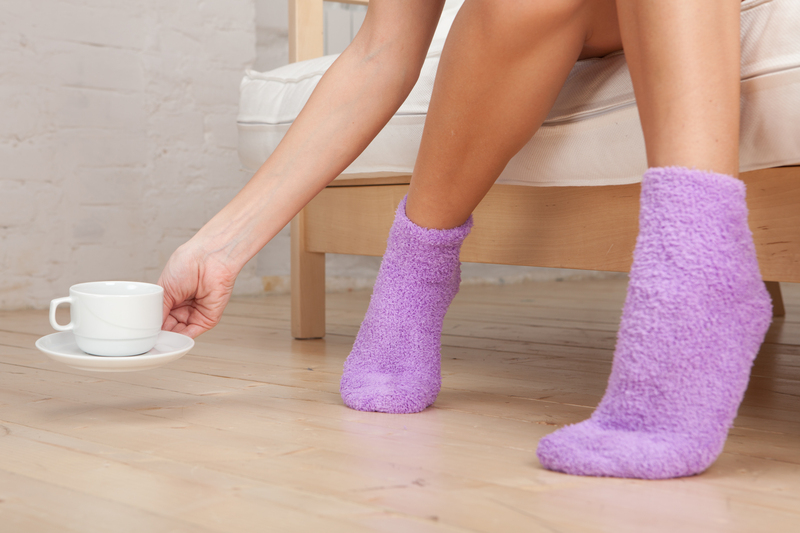How to Achieve Immaculate Curtains Every Time
Posted on 30/09/2025
How to Achieve Immaculate Curtains Every Time
Have you ever walked into a room and instantly noticed the pristine elegance of freshly cleaned and perfectly hanging curtains? Creating that level of perfection may seem elusive, but with the right techniques, care, and attention to detail, you can achieve immaculate curtains every time. In this comprehensive guide, we will explore the best practices to ensure your curtains remain fresh, spotless, and beautifully draped--adding a touch of sophistication to your home decor.
Why Immaculate Curtains Matter
Curtains are not just window coverings. They are an integral part of interior design that can dramatically alter the ambiance of your living space. Spotless, well-maintained curtains:
- Add personality and warmth to any room
- Frame windows and improve natural light diffusion
- Contribute to the cleanliness and freshness of the home
- Complement furnishings and color schemes
However, neglecting curtain care can have the opposite effect, turning a beautiful room drab and even affecting indoor air quality. That is why knowing how to maintain immaculate curtains is essential for any proud homeowner or renter.

Understanding Your Curtains: Fabric, Types, and Care Labels
Before embarking on curtain maintenance, it is crucial to understand the fabric and type of curtains you own. This knowledge will influence your cleaning method and frequency.
Curtain Fabrics and Their Requirements
- Cotton Curtains: Durable and machine-washable, but may shrink if not pre-shrunk.
- Linen Curtains: Best washed gently by hand or delicate machine cycle; tends to wrinkle, so steam care is important.
- Silk Curtains: Require dry cleaning or very gentle hand washing; silk is delicate and prone to water spots and fading.
- Polyester Curtains: Low maintenance, machine-washable, and typically wrinkle-resistant -- a great choice for a busy household.
- Velvet Curtains: Often need professional cleaning due to thickness and pile; gentle vacuuming is usually safe.
- Sheer/Voile Curtains: Lightweight and translucent, requiring light hand washing to prevent snags and tears.
Checking Care Labels is Essential
Care labels offer fundamental guidance on cleaning methods, temperature limits, and compatibility with detergents. Following these recommendations is a cornerstone of preserving flawless curtains and ensuring their longevity.
Routine Maintenance for Spotless Curtains
Regular maintenance is the heart of keeping your curtains looking immaculate all year round. Here's how to easily incorporate curtain care into your cleaning routine:
1. Weekly Dusting and Vacuuming
- Use the brush attachment of your vacuum cleaner to gently remove surface dust and allergens from curtains.
- Start from the top and work your way down using slow, deliberate strokes to avoid stretching the fabric.
- For delicate materials, use a lint roller or a feather duster.
2. Address Stains Promptly
- Spot clean stains as soon as you notice them using a clean, damp cloth and mild soap if appropriate.
- Test cleaning solutions on a hidden seam before applying to a visible area to avoid discoloration.
- For greasy stains or stubborn marks, consult the care label and use specialized products if needed.
3. Shake Out Daily
- Open your curtains daily to let in fresh air and prevent mustiness or mold.
- While opening, give them a gentle shake to release dust and discourage insect build up.
Deep Cleaning Techniques: The Secret to Immaculate Curtains
Deep cleaning is the key to keeping curtains spotless and odor-free. Frequency depends on the curtain location and household environment, but a safe rule is twice a year or when you do your Spring and Autumn cleaning.
1. How to Wash Curtains in a Washing Machine
- Remove curtain hooks, rings, and trims.
- Check care labels for temperature and cycle recommendations--the "delicate" setting is best for most materials.
- Wash similar colors together and use a mild detergent.
- Consider placing sheer or lightweight curtains in a mesh laundry bag for added protection.
- Do not overload the machine. Give curtains space to move freely.
- After washing, hang curtains back while still damp to prevent wrinkling and help them regain their shape.
2. Hand Washing Curtains
- Fill a bathtub or large basin with cold to lukewarm water and a gentle detergent.
- Submerge the curtains, swish gently, and avoid wringing to prevent creasing or damage.
- Rinse thoroughly with clean water to remove all soap residues.
- Press out excess water by rolling curtains in a clean towel, then hang them to air dry.
3. Professional Dry Cleaning
- Dry clean silk, velvet, heavy brocade, or lined curtains for best results.
- Always inform your professional cleaner about stains, delicate weaves, or trims so they can tailor their approach.
- Store-bought dry-cleaning kits offer a home option for some fabrics; always test on a small portion first.
4. Steam Cleaning Curtains on the Rod
- Many modern steamers allow you to freshen curtains while they hang.
- Fill the steamer, start from the top, and work down in smooth vertical motions.
- This method removes wrinkles, refreshes fabric, and kills dust mites without needing to take the curtains down.
5. Curtain Linings and Blinds
- Remember to clean liners and any blinds behind curtains at the same time to prevent dirt transfer.
- Wipe plastic or wooden blinds with a damp cloth; fabric blinds may require similar care as your curtains.
Maintaining the Perfect Curtain Appearance
Spotlessness is half the battle; the other half is presentation. Immaculate curtains should hang evenly, puddle just right, and appear crisp without excessive creasing.
Ironing and Steaming for Flawlessness
- Iron only when completely dry using the recommended heat setting for the fabric.
- Iron from the inside-out to protect colored or printed surfaces.
- Use a pressing cloth to avoid shine on delicate fabrics.
- For a fast alternative, use a steamer to quickly erase wrinkles while curtains remain on the rod.
How to Rehang Curtains to Avoid Creases
- Rehang curtains while still slightly damp after washing for a natural, wrinkle-free drop.
- Use curtain weights at the hem for clean, straight lines.
- Arrange pleats and folds evenly after hanging for a tailored finish.
Special Considerations for Different Curtain Types
Sheer and Lace Curtains
- Launder in a mesh bag or pillowcase to avoid tearing.
- Air dry by draping over a wide clothes rack to retain shape.
- Never twist or wring out, as this can warp the fabric.
Heavy Drapes and Blackout Curtains
- Vacuum the surface thoroughly before washing.
- Detachable linings may require separate washing.
- Due to their thickness, allow extra drying time and be vigilant against mildew.
Decorative or Embellished Curtains
- Avoid machine washing unless the label specifically states it is safe.
- Spot clean to protect embroidery, sequins, beads, or appliques.
- Consider professional cleaning for curtains with intricate details.
Protecting Curtains Between Washes
Preserving immaculate curtains is a long-term commitment. Try the following tips to help keep them at their best between washings:
- Open windows regularly to air out curtains and minimize odors.
- Avoid smoking inside or burning scented candles too close to windows.
- Rotate curtains seasonally if possible to prevent uneven fading and wear.
- Install curtain rods so panels slide fully open, allowing you to protect the fabric from harsh sun and pollutants when not in use.
- Add a sheer lining to protect decorative curtains from sun bleaching.
Common Curtain Cleaning Mistakes--And How to Avoid Them
- Nursing Wet Curtains: Don't allow curtains to sit wet or bunched up after washing, as this causes mildew and wrinkles.
- Ignoring the Label: Always follow the care label. Failure to do so is the main cause of shrinking, color loss, and damage.
- Using Harsh Chemicals: Steer clear of bleach or abrasive detergents, especially for colored or delicate fabrics.
- Overloading the Machine: Wash two panels at a time for optimal results and to avoid uneven cleaning or excessive creasing.
- Skipping the Final Rinse: Soap residue attracts more dust and dulls fabric. Be thorough in rinsing--whether by hand or in the machine.

Frequently Asked Curtain Questions
How often should I wash my curtains?
This depends on their exposure to dust, kitchen fumes, or smoke, but generally every 6-12 months is sufficient. High-traffic or pet-friendly homes may require more frequent care.
Can I put curtains in a dryer?
Most lightweight curtains can air dry, but select machine-dryer settings on a low heat option for sturdy, pre-shrunk materials. Remove promptly to prevent creasing and always check the label first.
How do I keep curtains smelling fresh?
Use natural air fresheners like baking soda sachets or lavender pouches, and be sure to ventilate your rooms regularly. Avoid masking odors with strong sprays, which can damage fabric fibers.
What if my curtains have mold or mildew?
Remove curtains immediately and wash with an anti-fungal solution appropriate for the fabric. Dry them thoroughly in sunlight if possible--the UV rays help kill remaining spores.
Conclusion: Immaculate Curtains Complete Every Room
Whether you are focused on daily upkeep or an annual deep clean, the path to immaculate curtains involves understanding your fabric, routine maintenance, and using the correct cleaning methods. Add the finishing touches with proper steaming or ironing, and hang your curtains proud knowing your windows are dressed to perfection.
With diligence and care, immaculate curtains will become the centerpiece of your window spaces--uplifting your interiors and leaving a lasting impression on anyone who steps inside. Start your curtain care regimen today, and enjoy spotless, elegant drapes every time!




